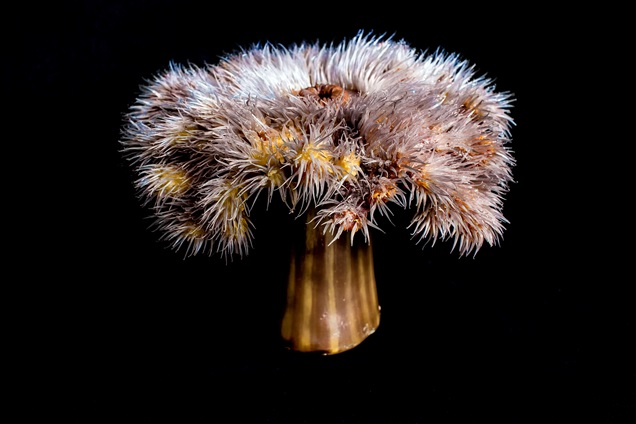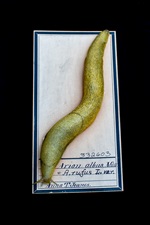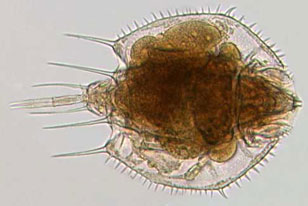General Invertebrates

The General Invertebrates Collection is worldwide in scope, with emphasis on localities in the Eastern and Gulf Coasts of the United States. The collection contains dry and alcohol-preserved specimens representing 14 phyla which includes Protozoa, Porifera, Cnidaria, Platyhelminthes, Gastrotricha, Rotifera, Nemata, Nematomorpha, Annelida, Arthropoda, Bryozoa, Brachiopoda, and Echinodermata. The systematically arranged collection contains 18,000 lots, about evenly divided between dry, alcohol-preserved, and prepared slides of specimens. Additionally, approximately 7,500 uncatalogued, unarranged alcohol-preserved lots document more recent collections by Academy researchers and their colleagues.
Staff

Paul Callomon, Malacology Collections Manager
General Queries
215 405-5096
callomon@ansp.org
Jason Weintraub, Entomology Collection Manager
Rotifera Queries
weintraub@ansp.org
About the Collection


|
The collection of types contains widely dispersed world localities. Many of these specimens represent collections acquired from foreign researchers, individual donors, and specimens surviving from world-venturing expeditions. Many specimens were collected during the Academy's first expedition, in 1817-1818, to the Sea Islands of Georgia and the east coast of Florida. Some specimens from such famous expedition as the United States Exploring Expedition around the world (1838-1842) were deposited with the Academy. Other specimens are accessory collections from Academy expeditions that concentrated on other areas of investigation; for example, many collectors and expeditions familiar to workers in the mollusk collection can be found sporadically through the entire General Invertebrates Collection.
|
The collection is strong in the arthropod class Crustacea, particularly the Decapoda, and in the phylum Annelida, particularly the classes Polychaeta and Hirudinoidea. Important taxonomically restricted collections within the overall collections are:
- Edward Potts Collection: Porifera (Spongillidae)
- Rotifera microslide collection
- J. Percy Moore Collection: Annelida (Polycheata, Hirudinoidae)
- Joseph Leidy Collection: parasitic organisms (Nemata, Nematomorpha)
- Felix-Edouard Guerin-Meneville Collection: Crustacea
Since 1948, staff of the Patrick Center for Environmental Research at the Academy of Natural Sciences of Philadelphia have surveyed the aquatic fauna and flora of more than 100 watersheds and estuaries, mostly in the eastern US, but also in Canada, Puerto Rico, and Peru. They used techniques pioneered by Academy scientist Dr. Ruth Patrick, for whom the Patrick Center is named. The surveys covered a broad range of taxa, including fish, diatoms, algae, sponges, flatworms, annelids, mollusks, crustaceans and insects, and aimed to determine the health of aquatic ecosystems. To search this collection, please click here.
Rotifera


|
The Academy of Natural Sciences of Drexel University houses the world's most comprehensive collection of rotifers on microslides. The collection is comprised of 1,935 slides covering 744 taxa from 34 countries. Some 96% of the slides are in excellent condition, largely due to the widespread use of pure glycerine as a mounting medium. A total of 1228 images belonging to 730 taxa from the collection are included in the online catalog. A CD-ROM edition of the catalog, A Magnificent Diversity: The Frank J Myers Rotifera Collection can be purchased online via Diane Publishing Co.
|
More information on the Rotifera Collection at the Academy can be found via the following links:
List of Available Names
Rotifer taxonomists, representing the community of rotifer scientists, have proposed, for; species group-level taxa in the phylum Rotifera, a candidate Part of the List of Available Names in Zoology (LAN) (see Article 79 of the International Code of Zoological Nomenclature). Comments from zoologists have been invited during twelve months of public viewing by the International Commission on Zoological Nomenclature, through the Commission's web site at www.iczn.org.
This public review period ended on 31 March 2013, and in April 2014 the Commission’s ad hoc committee informed the rotifer expert committee that they have recommended considering a revised proposal.
The second period of public commentary on this revised proposal of species-group level names began on 20 December 2015 and will end on 19 December 2016.
The revised proposal can be downloaded here.
This rotifer expert committee was endorsed at the International Rotifer Symposium in České Budějovice, Czech Republic (August 2015) to also propose a candidate Part of the List of Available Names in Zoology (LAN) for genus group-level taxa in the phylum Rotifera.
The first period of public commentary on this proposal of genus-group level names began on 20 December 2015 and will end on 19 December 2016. The proposal can be downloaded here.”